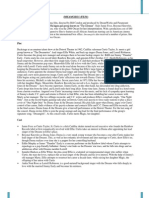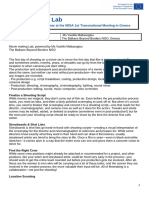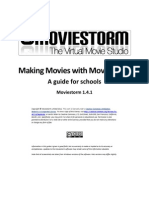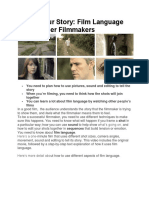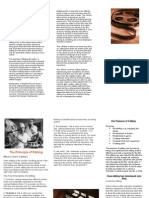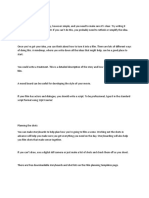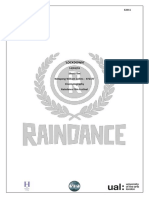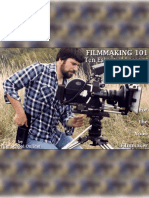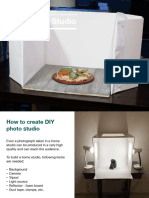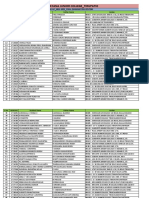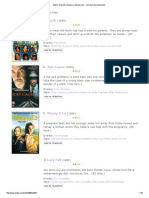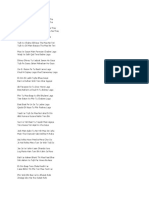0 ratings0% found this document useful (0 votes)
86 viewsFilm Process
Film Process
Uploaded by
api-677685512Copyright:
© All Rights Reserved
Available Formats
Download as PDF, TXT or read online from Scribd
Film Process
Film Process
Uploaded by
api-6776855120 ratings0% found this document useful (0 votes)
86 views8 pagesOriginal Title
film process
Copyright
© © All Rights Reserved
Available Formats
PDF, TXT or read online from Scribd
Share this document
Did you find this document useful?
Is this content inappropriate?
Copyright:
© All Rights Reserved
Available Formats
Download as PDF, TXT or read online from Scribd
Download as pdf or txt
0 ratings0% found this document useful (0 votes)
86 views8 pagesFilm Process
Film Process
Uploaded by
api-677685512Copyright:
© All Rights Reserved
Available Formats
Download as PDF, TXT or read online from Scribd
Download as pdf or txt
You are on page 1of 8
FILMMAKING PROCESS
Beginner’s guide to the
filmmaking process:
FILMMAKING PROCESS
Step 1: The Idea
Every movie you’ve ever seen first started with
an idea in someone’s brain. Although things
change as a project goes on, the story the
filmmakers come up with in the beginning will
serve as the foundation on which everything
else will be built. They thinking about the kind
of story they want their film to tell and all the
important story elements involved: plot,
characters, conflict, etc.
Ideas pop into our heads unexpectedly!
Filmmakers make sure to always carry a phone
or writing equipment to take down any cool
ideas that enhance the story.
It’s also a good idea to create a folder in which
they save newspaper and magazine articles,
snippets of overheard dialogue, notes on
characters they see on the street, and even
dreams.
FILMMAKING PROCESS
Step 2: The Script
The script is where filmmakers put down the
story, setting, and dialogue in linear form. This
important tool will be used by the rest of the
team to know what’s going to happen in the
film. They also use their own script as reference
throughout the process as well since they may
need to refresh yourself on certain actions,
dialogue lines, and more.
Filmmakers often make changes to the script
even after they think it’s ready. More often than
not, better ideas will come to well after this
stage in the filmmaking process.
Filmmakers often let their actors improvise,
whether it’s in rehearsal or on the set. They
may be surprised at what their actors are able
to imagine from their character’s point of view.
This is especially true for filmmakers who may
not be great with writing dialogue.
FILMMAKING PROCESS
Step 3: The Storyboards
A storyboard is a sequence of drawings that
represent the shots a filmmakers plan to film.
It helps to visualize each scene and decide on
things like camera angles, shot sizes, etc. It also
helps communicate what filmmakers is trying
to go for to other people on the set.
Photographing a storyboards can be a quick
solution.
A camera phone works fine for this. Just taking
a couple of friends to a location and telling
them, “You stand here, you stand there,” can
recreate the vision of shots a filmmaker might
be imagining.
FILMMAKING PROCESS
Step 4: The Cast and Crew
Assembling a team can be both exciting and
nerve-wracking.
For crew members, what is usually considered
is their past work and experience, and
filmmakers often request showreels or any
examples of work if available.
Holding an auditions to find the best actors
and actresses for roles is the best way.
FILMMAKING PROCESS
Step 5: The Locations
Sometimes filmmakers may need to
construct sets for a setting they would like
to have.
But for scenes where an actual location is
needed, they need to do some scouting to
find the best spots.
Great practice is take a camera and do as
much traveling as possible, snapping shots
of places that might serve as the perfect
setting for particular scenes.
Filmmakers always need to consider the
space required by the cast and crew. Space
shouldn’t be cramped and narrow, where
only the actors will fit well and not the
cameras, lights, etc.
FILMMAKING PROCESS
Step 6: The Filming
All the preparation and planning comes down
to this.
Filmmakers always make sure to have a shoot
script ready along with an organized schedule
of what will be filmed when.
Having enough of time to shoot scenes so that
they’re never rushed and can accommodate
for changes or problems. It’s common for a
scene that will last one minute in the final cut
to require more than five hours to film.
If time permits, filmmakers also try filming
the same scenes from new angles. This way,
they have more footage to work with that can
keep viewers engaged.
FILMMAKING PROCESS
Step 7: The Post-Production
Post-production is when filmmakers edit all
the footage to create a rough cut of the film.
Once done with the rough cut, they begin
adding things like sound effects, music, visual
effects, and colour correction. This process
will require the use of editing software.
Good practice for filmmakers is to show the
unpolished version to people whose opinions
they can trust.
It’s better to find out what isn’t working
sooner rather than when an audience is
watching the final version.
You might also like
- Filmmaking Guide Primary PDFDocument19 pagesFilmmaking Guide Primary PDFprakashNo ratings yet
- The Filmmaking ProcessDocument3 pagesThe Filmmaking Processricardo borrego100% (1)
- Master Shots Vol 3 - Sample 28 PagesDocument28 pagesMaster Shots Vol 3 - Sample 28 PagesMichael Wiese Productions86% (21)
- Dream GirlsDocument3 pagesDream GirlsMarilyn Zara Valverde RosasNo ratings yet
- Cinema of Attractions ReloadedDocument464 pagesCinema of Attractions ReloadedLuís Rocha Melo100% (3)
- Step 1: The Idea: A Storyboard Camera Angles, Shot Sizes, EtcDocument2 pagesStep 1: The Idea: A Storyboard Camera Angles, Shot Sizes, EtcashankarNo ratings yet
- 625 Final Paper PDFDocument16 pages625 Final Paper PDFKomalNo ratings yet
- Wisa_movie Making Lab ManualDocument20 pagesWisa_movie Making Lab ManualAnieNo ratings yet
- Film Making TemplateDocument28 pagesFilm Making Templatewjddn_nancyNo ratings yet
- Short Film MakingDocument3 pagesShort Film MakingGOPIO, Mark Anthony (A.)No ratings yet
- Mass Media Studies (Unit-2)Document47 pagesMass Media Studies (Unit-2)Shubham Rawat0% (2)
- Pre and Post - Production PlanningDocument14 pagesPre and Post - Production Planningtanisha gupta100% (1)
- Film Production ProcessDocument36 pagesFilm Production Processdmsngc55njNo ratings yet
- Development: Satyajit Ray, Was Known For His Perfectionist Attitude and Was Known To Sketch HisDocument3 pagesDevelopment: Satyajit Ray, Was Known For His Perfectionist Attitude and Was Known To Sketch Hismandy92manNo ratings yet
- The Best Tips For Making A Short Film in A Short Amount of Time MILDocument2 pagesThe Best Tips For Making A Short Film in A Short Amount of Time MILHoney Joy JuanNo ratings yet
- Mil Cheat SheetDocument10 pagesMil Cheat SheetAlenna CataloniaNo ratings yet
- How To Make A Movie 1Document7 pagesHow To Make A Movie 1Nin OrNo ratings yet
- 197212the No. 1 Question Everyone Working in PICTURESTART Should Know How To AnswerDocument5 pages197212the No. 1 Question Everyone Working in PICTURESTART Should Know How To Answerd4uqzjg395No ratings yet
- Making Movies With Movie Storm For SchoolsDocument41 pagesMaking Movies With Movie Storm For SchoolsSusan Forgie100% (1)
- Video School / Lesson: Behind The SceneDocument39 pagesVideo School / Lesson: Behind The SceneRegi FiandisaNo ratings yet
- FilmDocument6 pagesFilmCheeyan A.No ratings yet
- The Project:: Practical Production Audio/visual Task 1 November 2018Document1 pageThe Project:: Practical Production Audio/visual Task 1 November 2018Challoner MediaNo ratings yet
- Aspects of Film MakingDocument4 pagesAspects of Film MakingVINAYAK CHOPPARINo ratings yet
- In Depth DiscussionDocument29 pagesIn Depth DiscussionBlxck SnchzNo ratings yet
- Making Movies With Movie Storm For Schools PDFDocument41 pagesMaking Movies With Movie Storm For Schools PDFsa0611No ratings yet
- Unit 35Document24 pagesUnit 35api-391668494No ratings yet
- Telling Your StoryDocument64 pagesTelling Your StoryTri Yuni AuliaNo ratings yet
- Concept BookletDocument8 pagesConcept Bookletapi-435066883No ratings yet
- A Complete Guide to Producing a Short Film: A Case Study - Part 4 ProductionFrom EverandA Complete Guide to Producing a Short Film: A Case Study - Part 4 ProductionNo ratings yet
- Job Roles in Film Production STDocument5 pagesJob Roles in Film Production STSteven TweedaleNo ratings yet
- The Filmmaking ProcessDocument3 pagesThe Filmmaking Processricardo borrego100% (1)
- Melwyn Filmmaking Guide For Cine LiteracyDocument41 pagesMelwyn Filmmaking Guide For Cine Literacycesar yanezNo ratings yet
- 5 Tools Every Cinematographer Needs - HowToFilmSchoolDocument9 pages5 Tools Every Cinematographer Needs - HowToFilmSchoolloscloudsproductionsNo ratings yet
- NTCC WinayakDocument15 pagesNTCC WinayakWinayak KumarNo ratings yet
- 8 Mil Teleserye IndiefilmDocument28 pages8 Mil Teleserye IndiefilmNems IlocoNo ratings yet
- Reflection & Evaluation of PrelimDocument3 pagesReflection & Evaluation of PrelimsubhaanNo ratings yet
- Media Unit 16 LeafletDocument2 pagesMedia Unit 16 LeafletAkil Tj YearwoodNo ratings yet
- 2014 Filmmaking Step by StepDocument10 pages2014 Filmmaking Step by StepGorby Resuello100% (2)
- Producing A Music VideoDocument10 pagesProducing A Music Videomaxim.nosekNo ratings yet
- Maintaining ContinuityDocument4 pagesMaintaining ContinuityVanshika KathuriaNo ratings yet
- Audio Pre & Post Production in FilmsDocument45 pagesAudio Pre & Post Production in FilmssuriyaprakashNo ratings yet
- The StoryDocument3 pagesThe StoryPrasanna NammalwarNo ratings yet
- FilmmakingDocument6 pagesFilmmakingJhon Thor100% (1)
- ProposalDocument6 pagesProposalapi-373799466No ratings yet
- Obligatorio Filmmaking Readings English 1Document35 pagesObligatorio Filmmaking Readings English 1viceneffectNo ratings yet
- Elements of Film MakingDocument5 pagesElements of Film MakingJR Deviente100% (1)
- Film Documentary Script Writing Process Ijariie1273 Volume 1 14 Page 7 12Document6 pagesFilm Documentary Script Writing Process Ijariie1273 Volume 1 14 Page 7 12Kevin SmithNo ratings yet
- 30 Cinematography Techniques and TIps - StudioBinder PDFDocument4 pages30 Cinematography Techniques and TIps - StudioBinder PDFRajezhNo ratings yet
- l9 - Shooting Schedule GuideDocument3 pagesl9 - Shooting Schedule Guideapi-566381187No ratings yet
- Video TipsDocument3 pagesVideo Tipsapi-253379469No ratings yet
- CLASS 1 - Notes LinksDocument3 pagesCLASS 1 - Notes Linksolasogba1No ratings yet
- Statement of Aims FinishedDocument5 pagesStatement of Aims Finishedapi-642452602No ratings yet
- A.2 Case Study of Pre-Production Documentation: Jamie HoldenDocument6 pagesA.2 Case Study of Pre-Production Documentation: Jamie Holdenapi-330283324No ratings yet
- Evaluation Questions Georgia Linnard: Pre-ProductionDocument3 pagesEvaluation Questions Georgia Linnard: Pre-Productionapi-476846853No ratings yet
- Katies Task 2 - Logistics of Film ProductionDocument3 pagesKaties Task 2 - Logistics of Film Productionapi-543610760No ratings yet
- Flim MakingDocument18 pagesFlim MakingSami RatherNo ratings yet
- wk7 Brand EssenseDocument57 pageswk7 Brand Essenseapi-677685512No ratings yet
- What You Dont Know Can Hurt YouDocument5 pagesWhat You Dont Know Can Hurt Youapi-677685512No ratings yet
- User Research Meda 3Document22 pagesUser Research Meda 3api-677685512No ratings yet
- WK 3Document15 pagesWK 3api-677685512No ratings yet
- Case Study Meda 4Document20 pagesCase Study Meda 4api-677685512No ratings yet
- Editing in Premiere ReducedDocument36 pagesEditing in Premiere Reducedapi-677685512No ratings yet
- Documentary Narrative ReducedDocument12 pagesDocumentary Narrative Reducedapi-677685512No ratings yet
- Film Process Shot Size CompositionDocument19 pagesFilm Process Shot Size Compositionapi-677685512No ratings yet
- Market Research Meda 2Document17 pagesMarket Research Meda 2api-677685512No ratings yet
- Intro To Design Ethic Meda 1Document14 pagesIntro To Design Ethic Meda 1api-677685512No ratings yet
- MovementDocument9 pagesMovementapi-677685512No ratings yet
- Edit AudioDocument7 pagesEdit Audioapi-677685512No ratings yet
- Frame RateDocument7 pagesFrame Rateapi-677685512No ratings yet
- File ExtensionsDocument14 pagesFile Extensionsapi-677685512No ratings yet
- Model Release FormDocument13 pagesModel Release Formapi-677685512No ratings yet
- Product Photography ExampleDocument22 pagesProduct Photography Exampleapi-677685512No ratings yet
- Concept DevelopmentDocument32 pagesConcept Developmentapi-677685512No ratings yet
- Photo StagingDocument12 pagesPhoto Stagingapi-677685512No ratings yet
- Copyright Release FormDocument10 pagesCopyright Release Formapi-677685512No ratings yet
- Class 1Document37 pagesClass 1api-677685512No ratings yet
- Composition ReducedDocument38 pagesComposition Reducedapi-677685512No ratings yet
- wk-080314 - The Bank JobDocument1 pagewk-080314 - The Bank JobkatehasablogNo ratings yet
- ICICI Bank Probationary Officers Progamme - Merit List Batch 41Document17 pagesICICI Bank Probationary Officers Progamme - Merit List Batch 41UDITNo ratings yet
- Vendors 1Document51 pagesVendors 1Sunitha RNo ratings yet
- Film History & Criticism - Reading Summary - A Cinema of Attractions, Tom GunningDocument2 pagesFilm History & Criticism - Reading Summary - A Cinema of Attractions, Tom GunningalexNo ratings yet
- ContactsDocument2 pagesContactsBharath SangramNo ratings yet
- When I Die Ill Make Films in Hell Doris Wishman in MiamiDocument10 pagesWhen I Die Ill Make Films in Hell Doris Wishman in MiamiCinetrip Locatl100% (2)
- A Film by Cristian Mungiu: A Mobra Films ProductionDocument9 pagesA Film by Cristian Mungiu: A Mobra Films ProductionsoawesomemanNo ratings yet
- Bie-AP 2022-Exam Centers SRDocument7 pagesBie-AP 2022-Exam Centers SRRani SaiNo ratings yet
- Courier CompaniesDocument33 pagesCourier CompaniesFortune BuildersNo ratings yet
- Cachar 2Document20 pagesCachar 2djamit0398No ratings yet
- Elsaesser - A Reader On Melodrama PDFDocument14 pagesElsaesser - A Reader On Melodrama PDFMonique AguiarNo ratings yet
- IV ECE-B Project BatchesDocument3 pagesIV ECE-B Project BatchesANILNo ratings yet
- Top Lifetime Grosses - Box Office MojoDocument6 pagesTop Lifetime Grosses - Box Office Mojoimran zafarNo ratings yet
- Tata Steel WorkersDocument6 pagesTata Steel WorkersStripe WebNo ratings yet
- Arts WorksheetDocument12 pagesArts WorksheetApr CelestialNo ratings yet
- VaranasiDocument4 pagesVaranasiSwarochis Singh G L Bajaj IMRNo ratings yet
- Review of The Tempest BBCDocument10 pagesReview of The Tempest BBCapi-240150212No ratings yet
- Checking Out Types of Remote ControlsDocument3 pagesChecking Out Types of Remote ControlsDanna ZabatNo ratings yet
- Main Tenu Samjawaan Ki - Rahat Fateh Ali Khan (Virsa)Document7 pagesMain Tenu Samjawaan Ki - Rahat Fateh Ali Khan (Virsa)singhamitaNo ratings yet
- Taxi Driver AnalysisDocument5 pagesTaxi Driver AnalysisRamanathan IyerNo ratings yet
- Tips For Screenwriters How To Write A Script in 6 Basic Steps - 2022 - MasterClassDocument1 pageTips For Screenwriters How To Write A Script in 6 Basic Steps - 2022 - MasterClassOdunayo Dawodu100% (1)
- Output 3Document910 pagesOutput 3nch84041No ratings yet
- Eric LarsonDocument16 pagesEric LarsonMārs LaranNo ratings yet
- Cosmo.1 (Version 1) (Version 1) (Version 1)Document55 pagesCosmo.1 (Version 1) (Version 1) (Version 1)Feroz KhanNo ratings yet
- Insidious Film Analysis, First 5 Minutes of FilmDocument19 pagesInsidious Film Analysis, First 5 Minutes of FilmSophieNo ratings yet
- IMDb - Scarlett Johansson Movies List - A List by Ratul MajumderDocument10 pagesIMDb - Scarlett Johansson Movies List - A List by Ratul Majumdercoolhotpower337No ratings yet
- List of Students Invited To IMOTC 2020: Class VIII, IX, X, XIDocument2 pagesList of Students Invited To IMOTC 2020: Class VIII, IX, X, XIठा. सत्यवीर सिंहNo ratings yet
- PoetryDocument2 pagesPoetryChirpreet TutejaNo ratings yet




